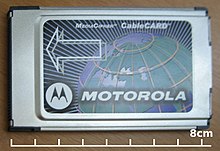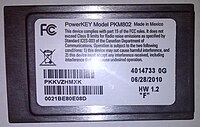
Cable television is a system of delivering television programming to consumers via radio frequency (RF) signals transmitted through coaxial cables, or in more recent systems, light pulses through fibre-optic cables. This contrasts with broadcast television, in which the television signal is transmitted over-the-air by radio waves and received by a television antenna attached to the television; or satellite television, in which the television signal is transmitted over-the-air by radio waves from a communications satellite orbiting the Earth, and received by a satellite dish antenna on the roof. FM radio programming, high-speed Internet, telephone services, and similar non-television services may also be provided through these cables. Analog television was standard in the 20th century, but since the 2000s, cable systems have been upgraded to digital cable operation.
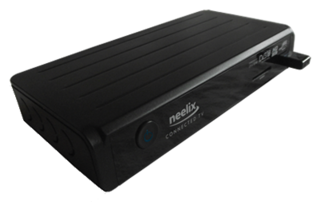
A set-top box (STB), also known as a cable box or receiver and historically television decoder, is an information appliance device that generally contains a TV-tuner input and displays output to a television set and an external source of signal, turning the source signal into content in a form that can then be displayed on the television screen or other display device. They are used in cable television, satellite television, and over-the-air television systems as well as other uses.
Digital cable is the distribution of cable television using digital data and video compression. The technology was first developed by General Instrument. By 2000, most cable companies offered digital features, eventually replacing their previous analog-based cable by the mid 2010s. During the late 2000s, broadcast television converted to the digital HDTV standard, which was incompatible with existing analog cable systems.
A digital video recorder (DVR) is an electronic device that records video in a digital format to a disk drive, USB flash drive, SD memory card, SSD or other local or networked mass storage device. The term includes set-top boxes with direct to disk recording, portable media players and TV gateways with recording capability, and digital camcorders. Personal computers are often connected to video capture devices and used as DVRs; in such cases the application software used to record video is an integral part of the DVR. Many DVRs are classified as consumer electronic devices; such devices may alternatively be referred to as personal video recorders (PVRs), particularly in Canada. Similar small devices with built-in displays and SSD support may be used for professional film or video production, as these recorders often do not have the limitations that built-in recorders in cameras have, offering wider codec support, the removal of recording time limitations and higher bitrates.
Conditional access (CA) is a term commonly used in relation to software and to digital television systems. Conditional access is that ‘just-in-time’ evaluation to ensure the person who is seeking access to content is authorized to access the content. Said another way, conditional access is a type of access management. Access is managed by requiring certain criteria to be met before granting access to the content.
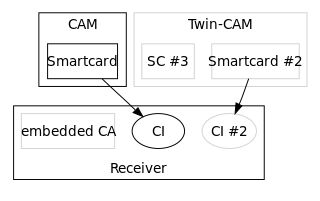
In Digital Video Broadcasting, the Common Interface is a technology which allows decryption of pay TV channels. Pay TV stations want to choose which encryption method to use. The Common Interface allows TV manufacturers to support many different pay TV stations, by allowing to plug in exchangeable conditional-access modules (CAM) for various encryption schemes.
The OpenCable Application Platform, or OCAP, is an operating system layer designed for consumer electronics that connect to a cable television system, the Java-based middleware portion of the platform. Unlike operating systems on a personal computer, the cable company controls what OCAP programs run on the consumer's machine. Designed by CableLabs for the cable networks of North America, OCAP programs are intended for interactive services such as eCommerce, online banking, Electronic program guides, and digital video recording. Cable companies have required OCAP as part of the Cablecard 2.0 specification, a proposal that is controversial and has not been approved by the Federal Communications Commission. Cable companies have stated that two-way communications by third party devices on their networks will require them to support OCAP. The Consumer Electronics Association and other groups argue OCAP is intended to block features that compete with cable company provided services and that consumers should be entitled to add, delete and otherwise control programs as on their personal computers. On January 8, 2008 CableLabs announced the Tru2Way brand for the OpenCable platform, including OCAP as the application platform.
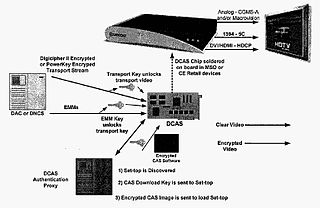
Downloadable Conditional Access System or DCAS was a proposal advanced by CableLabs for secure software download of a specific Conditional Access client which controls digital rights management (DRM) into an OCAP-compliant host consumer media device. The National Cable & Telecommunications Association (NCTA) proposed that DCAS be used as a substitute for physical CableCARDs, a standard also created by CableLabs for which products began appearing in August 2004 as part of industry compliance to the FCC mandate, which in turn is pursuant to the Telecommunications Act of 1996. DCAS is growing in popularity as a less expensive alternative for CableCARD, with major North American operator deployments from Cablevision and Charter. DCAS deployments can be expected to grow in the coming years, thanks to favorable regulatory view from the STELA Reauthorization Act of 2014 and FCC appointing a Downloadable Security Technical Advisory Committee, and wider support for key ladder (K-LAD) functionality from system-on-chip (SoC) vendors and set-top box manufacturers.
Cable-ready is a designation which indicates that a TV set or other television-receiving device is capable of receiving cable TV without a set-top box.

Switched video or switched digital video (SDV), sometimes referred to as switched broadcast (SWB), is a telecommunications industry term for a network scheme for distributing digital video via a cable. Switched video sends the digital video more efficiently freeing bandwidth. The scheme applies to digital video distribution both on typical cable TV systems using QAM channels, or on IPTV systems.
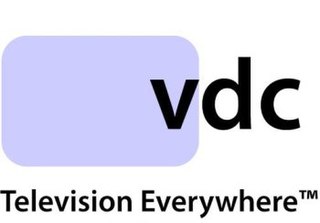
VDC Corporation was a distributor of multichannel video programming that delivered live cable television through broadband connected computers in the United States. They developed and were involved in the distribution and delivery of live cable television programming channels.
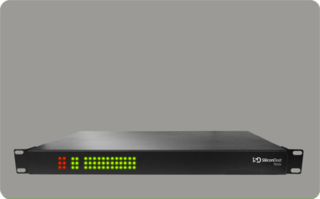
HDHomeRun is a network-attached digital television tuner box, produced by the company SiliconDust USA, Inc.
Multichannel television in the United States has been available since at least 1948. The United States is served by multichannel television through cable television systems, direct-broadcast satellite providers, and various other wireline video providers; among the largest television providers in the U.S. are DirecTV, Altice USA, Charter Communications, Comcast, Dish Network, Verizon Communications, and Cox Communications. The Telecommunications Act of 1996 defines a multichannel video programming distributor (MVPD) as "a person such as, but not limited to, a cable operator, a multichannel multipoint distribution service, a direct broadcast satellite service, or a television receive-only satellite program distributor, who makes available for purchase, by subscribers or customers, multiple channels of video programming", where a channel is defined as a "signaling path provided by a cable television system."
Digital television in the United States is available via digital terrestrial television (DTT), digital cable, satellite television, and IPTV providers.

A cable converter box or television converter box is an electronic tuning device that transposes/converts channels from a cable television service to an analog RF signal on a single channel, usually VHF channel 3 or 4, or to a different output for digital televisions such as HDMI.
Tru2way is a brand name for interactive digital cable services delivered over the cable network. Services include interactive program guides, interactive ads, games, chat, web browsing, and T-Commerce. The brand also appears as <tru2way> and is used to market cable services, applications, and devices that support the tru2way cable architecture. Tru2way is the successor name for technology known as OpenCable. Major cable operators committed to deploy the tru2way platform in service areas covering more than 90 million U.S. homes by the end of 2008.
AllVid was a proposal to develop technology enabling smart broadband-connected video devices to access the content on the managed networks of cable operators, telcos, and satellite-TV operators. It was initially proposed in the U.S. Federal Communications Commission's (FCC) National Broadband Plan in 2010. The AllVid hardware would act as a universal adapter for all types of pay TV content such as video-on-demand and pay-per-view, as well as interactive programming guides, delivered through a wide variety of means, including cable TV, satellite TV, VDSL, IPTV, and Internet TV.
An over-the-top (OTT) media service is a media service offered directly to viewers via the Internet. OTT bypasses cable, broadcast, and satellite television platforms—the types of companies that have traditionally acted as controllers or distributors of such content. It has also been used to describe no-carrier cellphones, for which all communications are charged as data, avoiding monopolistic competition, or apps for phones that transmit data in this manner, including both those that replace other call methods and those that update software.
CloudTV is a software platform that virtualizes CPE or STB functionality, enabling pay-TV operators and other video service providers to bring advanced user interfaces and online video experiences such as YouTube and Hulu to existing and next-generation cable television and IPTV set-top boxes and connected consumer electronics devices.
VidiPath is a set of guidelines developed by the Digital Living Network Alliance (DLNA) that enables consumers to view subscription TV content on a wide variety of devices including televisions, tablets, phones, Blu-ray players, set top boxes (STBs), personal computers (PCs) and game consoles without any additional intermediate devices from the service provider. Consumer Electronics (CE) products that are certified to the VidiPath Guidelines can directly support the full range of subscriber HD programs, movies, DVR content, channel guides, and other premium features, all with a consistent user interface (UI) from their service provider.
